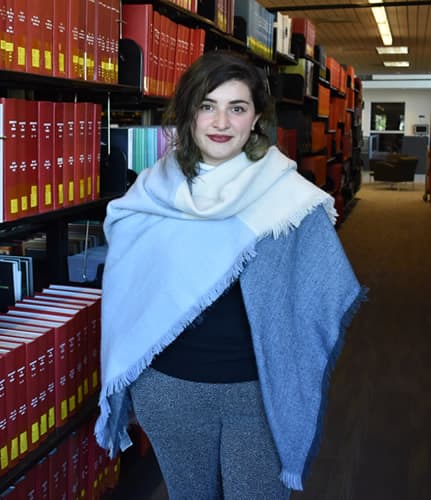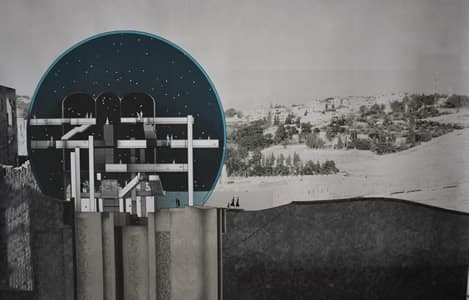
As campus emptied on the Friday afternoon before spring break, Noushin Radnia was still hard at work conducting research in Storrs’ Digital Arts Lab. One of three recipients of the School of Architecture’s Scholarship in Practice awards for 2017-18, Radnia is working toward a master’s degree in design computation, a dual master’s program in the fields of architecture and computer science. She plans to graduate from this unique program in spring 2018.
The Design Computation program, the first of its kind in the United States, graduated its first class in 2015. Graduates of the program are equipped with knowledge and skills necessary to lead the integration of computer science into architectural design and research. Program coordinator Chris Beorkrem, an associate professor in the School of Architecture, said the program’s faculty are devoted to training students to adapt to a design profession that is becoming increasingly computational.
“Research in the program has tended to focus on experimental use of robotics, machine learning, human and computer interaction and data visualization,” he said. “And it’s all with an eye toward solving design problems.” This multifaceted approach attracted Radnia to the program, and she now has an internship to advance her skills in specialized approaches to design.
This summer, Radnia will begin her scholarship work with C DESIGN, an architectural, interior design and planning firm. She will continue to work there part time in 2017-18 as she finishes her coursework.
During her time with C DESIGN, Radnia hopes to use her dual degree skills to work on digital design as well as animation. Her program often emphasizes the use of responsive architecture, which incorporates responsive technologies into the structural systems of buildings. This allows a building to adapt and respond to its environment to save energy or otherwise benefit building occupants. Radnia emphasizes the importance of implementing new technologies in architectural design.
“With the pace that the world is going, the architecture industry is realizing how important computation is in keeping up with the competition,” she said.
Before starting her program at UNC Charlotte in 2015, Radnia studied architecture in her native Iran. She worked at a small architecture studio for several years before deciding to return to school to narrow her research interests. With the encouragement of her boss in Iran, Radnia did her research and found the unique nature of the Design Computation program at UNC Charlotte attractive.
 Each semester, architecture students choose a studio. This approach, in place of traditional classes, gives students personalized, hands-on instruction in architectural design and research. During her time at UNC Charlotte, Radnia has engaged in various research projects by collaborating with departments ranging from religious studies to mechanical engineering. During her first semester, she designed a concept for a building in Charlotte devoted to brain cancer research; the most interesting part of this project for her, she said, was exploring how a building could respond to neurological diseases. Other projects include the design of a high-rise building in Charlotte and an archaeology museum in Jerusalem.
Each semester, architecture students choose a studio. This approach, in place of traditional classes, gives students personalized, hands-on instruction in architectural design and research. During her time at UNC Charlotte, Radnia has engaged in various research projects by collaborating with departments ranging from religious studies to mechanical engineering. During her first semester, she designed a concept for a building in Charlotte devoted to brain cancer research; the most interesting part of this project for her, she said, was exploring how a building could respond to neurological diseases. Other projects include the design of a high-rise building in Charlotte and an archaeology museum in Jerusalem.
Radnia’s most recent studio project emphasizes the value of her program and its ability to integrate digital aspects into architectural practice and research. Witnessing the homelessness on North Tryon Street, she is tackling the development of a smartphone app to connect the homeless to the greater Charlotte community. The app, which she has named “Invisible People,” is part of a digital storytelling initiative to create a North Tryon “Smart District.”
Through this project, she hopes to set up stations equipped with recording devices along North Tryon. At these stations, homeless people could use available technology to record their stories as audio or text files. Radnia’s project will create a much-needed space for people to tell their stories, but it also has the potential to be used for emergency communication. She said the digital storytelling aspect of the app will encourage other members of the Charlotte community to foster connections with the homeless population.
Radnia anticipates “Invisible People” will bring visibility to the homeless population by designing a space for them to tell their stories using available technology. This, to Radnia, is the most important part of her program. “That’s the real reason I chose this path,” she said. “I wanted to be able to link humanity and technology together.”
To apply to the Design Computation dual-degree program, visit the Graduate Admissions website.
(Photo inset: An example of Radnia's work.)